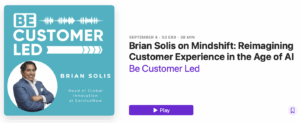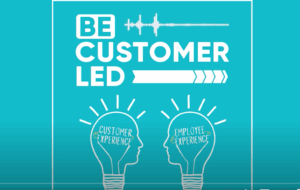Customer experience (CX) is the new black and it is, for all intents and purposes, the catalyst for accelerated and purposeful digital transformation. In my research however, I find that customer experience is not truly a customer-first initiative. It is in many cases relegated to enterprise-first approaches to improve customer flow from an infrastructure perspective. It’s not necessarily something I’m calling out as a problem. Optimizing customer journeys is indeed necessary. But, it is not a means to an end. It is merely a means to addressing part of the opportunity. There’s a difference between customer-centric and customer-engaged as my dear friend Paul Greenberg emphasizes. Offering better prices, improved services, and streamlined touchpoints are helpful. But that is not engagement. Driving for change to improve how people feel about your brand, in every moment, throughout the customer lifecycle, is how companies stimulate CX into a genuine competitive advantage.
I recently sat down with the team at Kampyle/Medallia to talk about the state and future of CX. I wanted to share that discussion with you here in the hopes of helping you in your work.
Kampyle: Can you tell us how you got into CX and why you find the space so interesting?
Brian Solis: In the late 1990’s, I focused on the impact of the internet on the customer journey and it’s constant evolution; how digital devices were affecting decision making, how touchpoints were developing and what new opportunities there were for touchpoints, as reflected by the technology roadmaps. What I observed over those years were the many, many different ways consumers were making decisions and also the many ways brands could – but weren’t – reaching consumers and B2B customers.
Recently we’ve seen a massive increase in the importance of CX – why do you think that is?
CX has increased progressively over the years simply because its importance was inevitable. Since my work in 1997 however, it is both surprising and unsurprising how slowly companies move. Markets were shifting yet philosophies and systems and operations and processes were not evolving. That came to a head a couple of years ago – with digital transformation there now became a sense of urgency.
Also, companies change for one of two reasons: one is because you have a leader who recognizes the Aha! moment or you have management that recognizes the Uh-Oh moment. It’s almost like Netflix v. Blockbuster or Amazon v. Borders – there’s this understanding of how customers are changing, and then companies become customer centric in their efforts to develop new CX strategies.
I will say this, however – I think companies are still struggling with CX because they’re leaning on it as a technology solution when it really requires human perspective and technology enablement. The reason there is this disconnect is because the truth is, with most companies – no matter how much CX they invest in – is that they are not customer centric, they are shareholder-centric, and they are always looking for ways to deliver shareholder value. The entire purpose of CX, however, is to deliver a customer experience that customers expect and cherish. That is so far from where companies are focused, that there’s almost this renaissance that has to happen within the C-suite, in order to expedite CX and for it to be meaningful and help the company be competitive for the next generation.
Who do you think needs to own CX in a company?
What I’ve found in some of the more progressive organizations, is that there’s this new management committee, that’s formed as a means to tackle this very urgent subject.
Due to the silos that exist within companies – because of how businesses have been designed and built over the last 50 years – each one of the touchpoints on a customer’s journey is often owned by a separate business group within the company. But the customer doesn’t care about that or internal politics within the company. They care – more now than they ever have – about getting what they want, when they want and how they want. So the challenge is unless you want to deliver a broken customer experience, then those groups have to collaborate in order to fix the problem. That means a new body needs to oversee and move everyone in the same direction. That’s the fastest and most efficient way.
Which CX metrics do you think are the most important?
I think there are traditional metrics that are important, but I also think there needs to be a new series of metrics that captures the experience, not just in the moment, but also the sum of all moments. I think that’s the one thing about CX that we tend to miss. We measure CX by moments because that’s all we have the power to do, so it’s purely reflective of how you feel in that moment; during that particular exchange or transaction.
But if you take the automotive purchase for example; there’s the experience of someone shopping, the experience of reviewing the website, at the dealership, during the sales transaction and when the car’s brought into for service etc.… And we need to think – what is the experience we want to deliver at each of these touchpoints? That’s the ultimate metric. We have to start by defining the experience, and then deploying that experience – almost as if you have a style guide – and then measure it against the moments and the sum of its parts. At the end of the day, that’s what CX is – the sum of each engagement the customer has with the business throughout their life cycle.
How important is customer feedback as a component of customer experience?
I think customer feedback is important. I think listening is important – sometimes you don’t hear the customers the way you need to. I encourage any company that wants to be competitive, to look outside their industry and traditional customer base to see what they’re not getting.
What I mean by that is Uber for example. Uber is a competitor to nearly every company these days, simply because they’ve simplifies transactions and delivered a new standard for customer engagement and service. That can apply to insurance or health care – it can apply to anything. The best companies are looking outside to figure out what customers aren’t even telling them; to see opportunities to deliver great customer experiences that customers are having in other aspects of their life and work, and using that for inspiration.
What’s the best piece of advice you can give a business trying to improve their customer experience?
I think the challenge we have here, is that we’re trying to make decisions about the future of CX based on legacy mindsets of how the customer operates, simply because of how we as a company operate. I think that’s dangerous. The best advice is to consider that what you’re doing today isn’t necessarily the standard for how you need to it tomorrow. There’s a lot of opportunity and room for invention. Iteration and innovation – that’s what needed. We also toss around the word empathy quite a bit, but it’s a really important word. We need to understand how customers are making decisions in their world, in their way, rather than continuing with an existing legacy journey just because that’s what exists.
The real opportunity is to realize that customers are making decisions their way and will continue to do so. We have to build bridges that go where they’re going, instead of trying to force them to conform to what we have. That’s a real business revolution right there – simply looking at new ways to work, that match how consumers are evolving and how they work in their day to day lives. I think that’s a real great place to start. Otherwise, we have these blinders on and we see customers through this lens of a legacy that doesn’t allow us to appreciate them and how they’re evolving.
Which companies today do you think have great CX? Why?
It’s hard to answer that questions because I don’t think companies are looking at CX holistically. For example, Zappos – they have great customer service but that’s just one part of the customer experience. I think the Zappos website is atrocious! Shopping on Zappos is a complete mess.
So you have semblances of innovative customer experiences, but if you apply that question to CX as the sum of all parts, then you have to look at things like the Disney Resorts. Being on a Disney property is an incredibly thoughtful experience. Every aspect, from the food to the rides – everything is shaped as part of a holistic experience. But again, the Disney website is atrocious as it’s very dated. So I think it’s actually a question that we need to be challenging companies with. Companies need to stop taking comfort or pride in the moment and start challenging themselves to think about CX holistically.
What do you think will be the main CX trends this year?
I think the big trend is going to be (unfortunately), Artificial Intelligence and explorations into virtual reality. Trends like chatbots and other immerging technology as a means to deliver gimmicks rather than solutions, which is what many companies have been guilty of doing for ages.
I will tell you that the real secret trend is one that’s continuing on from last year – which I wrote about in The Six Stages of Digital Transformation – which is that companies are going to use CX as a catalyst to bring about organizational change and to dictate new technology roadmaps and product roadmaps. That’s the ultimate trend or at least the ultimate hope – to see the future through a human lens that is reflective of the evolving customer, rather than our interpretation of them.
Photo Credit: Mike Larremore
Brian Solis is principal analyst and futurist at Altimeter, a Prophet company, world renowned keynote speaker, and 7x best-selling author. His latest book, X: Where Business Meets Design, explores the future of brand and customer engagement through experience design. Follow him on Twitter and LinkedIn. Invite him to speak at your next event.









Leave a Reply